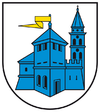Jelsa
| Jelsa | ||
|
||
|
|
||
| Basic data | ||
|---|---|---|
| State : |
|
|
| County : |
|
|
| Island : | Hvar | |
| Height : | 0 m. i. J. | |
| Area : | 146.28 km² | |
| Residents : | 3,582 (2011) | |
| Population density : | 24 inhabitants per km² | |
| Telephone code : | (+385) 021 | |
| Postal code : | 21 465 | |
| License plate : | ST | |
| Boat registration : | JL | |
| Structure and administration (status: 2013, cf. ) |
||
| Community type : | local community | |
| Mayor : | Nikša Peronja (independent) | |
| Website : | ||
Jelsa [ ˈjɛːlsa ] is a port on the island of Hvar in Croatia.
location
The town of Jelsa is located on the north side of the Dalmatian island of Hvar . It is surrounded by the two largest peaks on the island, Nikola and Hum . Depending on the weather, you can see the neighboring island of Brač and the mainland. A catamaran of Jadrolinija commutes daily between Jelsa and the port of Split . A seaplane of the European Coastal Airlines operates four times on day between the port and the Split airport . You can easily rent one of the numerous boats to the neighboring islands. There is also a bus connection to the neighboring towns.
history
The area where the city of Jelsa is located today was inhabited as early as the Stone Age. Back then, people lived in caves in the southeast of today's city. The first buildings came to this region with the Greeks . Later, seven castles , called “Kaštela” (from Latin castellum, castle) in the local dialect , were built to warn of the attacks by the Turks and thus to protect the wealth of the settlement. It was not until the 14th century that Jelsa was first mentioned as a city proper. At that time it developed into one of the most important shipbuilding centers of the time.
economy
Tourism is the main source of income for the city of Jelsa. This has been around in Jelsa since ancient times, as evidenced by the ruins of the country villas (lat. Villae rusticae (Pl.)) That were used as holiday homes. The first hotel was opened in 1911. At the end of the 1960s, the construction of larger tourist facilities began. Other important industries are viticulture, the cultivation of olives and the products obtained from them such as traditional olive oil, as well as fishing and traditional lavender oil.
Attractions
The municipality of Jelsa offers several sights. There are z. B. Perivoj (pleasure garden) from around 1870. Since Jelsa, like Croatia, is generally Catholic , there are a large number of chapels and churches , above all the castle church of St. Mary . The most beautiful place in Jelsa is St. Ivan's Square and the associated chapel. It is located in the old town of Jelsa. Remains of the city wall and a cemetery on the site of a former Augustinian monastery (1605–1787), of which the monastery church still testifies, have survived the ages of the ancient city of Civitas Vetus Ielsae . In cooperation with historians and experts, a Roman wine cellar was built above the town.
Town twinning
The twin city of Jelsa is St. Andrä in Austria . The contract was signed in 1997.
sons and daughters of the town
- Antun Dobronić , Croatian composer
- Miro Modrinić , Croatian author










